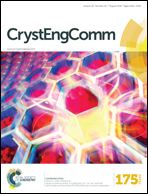Self-template fabrication of one-dimensional hollow and solid porous titania by chemically induced self-transformation†
Abstract
In this article, we describe a general strategy, which combines electrospinning and hydrothermal processes, for the facile fabrication of one-dimensional hollow and solid porous titania (1DHP-TiO2 and 1DSP-TiO2). Amorphous TiO2 fibres were first fabricated by a conventional electrospinnning method and then used as precursors and templates for the subsequent hydrothermal reaction. Fluoride-mediated chemically induced self-transformation (CIST) was proposed to account for the formation of the hollow and solid porous structures. By controlling the parameters of the processes (i.e. porosity and diameter of the amorphous precursors, type of the mediated reactants), titania with tunable wall thickness and inner structures could be selectively fabricated. Besides, the obtained 1DHP-TiO2 and 1DSP-TiO2 exhibited good thermal stability. The organic residues and trace amounts of Na ions in 1DHP-TiO2 and 1DSP-TiO2 may act as stabilizers to raise the phase transformation temperature. Through this current general strategy based on CIST, it is expected that more functional 1D hollow and solid porous inorganic materials for advanced applications can be designed.


 Please wait while we load your content...
Please wait while we load your content...